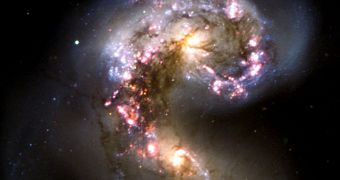Investigators at the University of Kashiwa, in Japan, led by expert Dr. John Silverman, argue that supermassive black holes are more likely to develop at the core of merging galaxies than anywhere else. These conclusions are based on statistical analysis of images showing galactic collisions.
Galaxies that currently exist in tightly-knit pairs are 50 percent more likely to contain such dark behemoths at their cores than their smaller counterparts. Generally speaking, astronomers have the highest chance of finding an SMBH inside massive galaxies.
Our Milky Way, for example, may or may not be host to such a dark object. While some studies suggest this to be the case, most astrophysicists are not yet convinced of this. By comparison to other cosmic structures, our galaxy is fairly large, with a diameter of 120,000 light-years.
One would expect to find an SMBH in such a large galaxy, but studies conducted to demonstrate this in a scientific manner have thus far come up short. Still, in the case of larger galaxies – including our neighbor Andromeda – the large black holes can always be seen.
In colliding galactic systems, the dark behemoths develop even if none of the original galaxies had one when the collision began. There are several ways in which an SMBH can develop, and one of them is through the merger of two, normal-sized black holes.
The international team of researchers that conducted the new work used the NASA Chandra X-ray Observatory to analyze a large number of colliding galaxies. The European Southern Observatory's (ESO) Very Large Telescope (VLT) also contributed to this survey, Daily Galaxy reports.
Chandra is very well suited to identifying galaxies which house a growing supermassive black hole. As the objects accrete more and more mass, they produce a specific type of X-rays, which the telescope's sensitive detectors can pick up.
Details of the new investigation were published in the latest issue of the esteemed Astrophysical Journal. However, the study also reveals an interesting phenomenon – galactic collisions cannot account for the entire SMBH growth process.
As such, experts propose the existence of some X factor that is allowing the objects to accrete increasing amounts of mass as they grow older. Astronomers are intrigued by the idea, and will most likely start to investigate the matter in depth as soon as possible.

 14 DAY TRIAL //
14 DAY TRIAL //